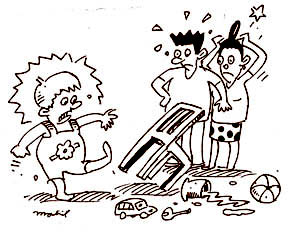|
observer |
|
|
|
|
|
OTHER LINKS |

|

|

|
|
How parents can deal with....: The little emperor's aggressive behaviourHe is only four-years-old, but he is the most important person of your family. Here, in this series explain just how to tame those tiny tyrants. Aggression can be defined as behaviour that results in personal injury to another. This injury can be psychological (verbal attacks) as well as physical. Child also tends to be impulsive, easily irritable, immature, inarticulate about feelings and has difficulty taking criticism or frustration. Reasons why....
2. Child is rewarded for aggressive acts, that is, he gets his own way or the attention that he wants. 3. Behaviour is triggered by the frustrations of daily living, that is, child reacts aggressively when an obstacle prevents him from satisfying a need. 4. Child is exposed to mass media that glamorize violence. 5. Child lacks assertive skills in relating with other children. 6. Emotional needs of child like the need for love and security, praise and recognition are unmet. How to prevent.... 1.Limit your child's exposure to violence in TV. Use violence on TV to point out to him the adverse consequences and non-violent alternatives. 2.Consistently enforce rules that promote "love and respect" such as "no hitting" and "no teasing". 3.Avoid discipline that is overly permissive or autocratic. 4.Provide opportunities for physical exercises to drain off tension, energy and aggressive impulses. 5.Model non-aggressive ways of expressing your anger and frustration like the use of compromise and negotiation. 6.Provide more adult supervision in child's activities to discourage aggressive reactions. 7.Rearrange environment by providing more physical space for child to play in. This will reduce the likelihood of him getting into another child's way. 8.Minimize marital strife where parents exhibit a high level of arguing, conflict and aggression. What to do.... 1.Strengthen the loving feelings between you and your child by spending sufficient quality time alone with him. 2.Catch your child being good. Praise, encourage or reward your child for non-aggressive acts such as playing without fighting or yelling. 3.Use a chart to record how often your child plays cooperatively and challenge him to do it more often. 4.Use "time-out" to isolate your child from on-going social activity. 5.Teach your child assertive skills. He can learn to give the offender an objective description of the offending behaviour together with his personal reaction to this and make a request for expected behaviour; for example, "I was playing with the ball when you grabbed it away from me. I don't like it when you do that. Can I have my ball back." 6. Train your child to talk himself out of this aggression. Help him to say quietly to himself thoughts of self control like "Talk, don't hit" and "Stop and think before you act". 7. After your child has cooled down, discuss with him the adverse consequences. You can also discuss alternative ways to solve his problems like compromising, have an adult intervene or walking away. What not to do.... 1. Use aggression to stop aggression. 2. Lose your temper by yelling and screaming. 3. Use physical punishment frequently. 4. Scold, judge, criticize, lecture and confront child. 5. Remind your child of his past aggression. Source: Handling common problems of children. |
 1. Child learns behaviour by observing the example set by others such
as parents, siblings and peers.
1. Child learns behaviour by observing the example set by others such
as parents, siblings and peers. 







